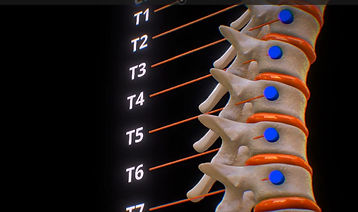

MODULE 1
THE SPINE

1.1 Introducing The Spine
The course kicks off by introducing the spine, it's components and their function. Using state-of-the-art 3D models, the trainee is shown animated depictions of the human spine and spinal cord, to give them a good feel for how the structures look and function.

1.3 The Thoracic Vertebrae
Moving on to the Thoracic Vertebrae, the 3D model turns slowly showing the trainee how the vertebrae support the rib-cage, how many bones there are and the function that remains after a break in this area. Trainees are also shown the critical effect breaks above T12 can have on clients and how it affects their lives.

1.5 The Sacral Vertebrae
The 3D model tips slightly, to give the trainee a good perspective of this triangular vertebrae whilst the presenter explains it's function.

1.7 Intervertebral Discs
Finally, the presenter shares the function of the intervertebral discs, the role they play in the overall structure of the spine and their vulnerabilities.

1.2 The Cervical Vertebrae
Beginning with the Cervical Vertebrae, the student is shown how many bones comprise this part of the spine and also taught the effect that a break in this area can have and the condition it renders in the client.

1.4 The Lumbar Vertebrae
Moving down the spine, the trainee is presented with 3D graphics depicting the Lumbar vertebrae. Here, they learn how most people suffer pain in this area and a story is shared with them about a person who suffered damage in this area and how it affected them.

1.6 The Coccygeal Vertebrae
While the coccygeal vertebrae represent the smallest bones in the spine, their presence is vital non-the-less. The introductory presentation to the spine shows these bones and explains the consequences of damaging them.
